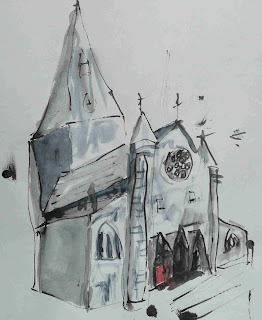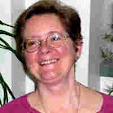Mandala, a process
The theme of the
Nuit blanche in Montreal this year is Red, and Christ Church
Cathedral, my church, is hosting and exhibition of art by its
members. I am calling my paintings “ painting RED.” I
looked around the Christ Church Cathedral where the exhibit is to be
held, and found a number of red objects, including, I thought, the
triangular red windows at the top of the stained glass windows in the
front of the church.
I photographed these
windows. I enlarged the photo of just one of the small windows to
get the detail. I studied them in in the most revealing way possible,
by attempting to draw, then paint, them.
The triangular
window had a three-fold symmetry. The corner red panes seemed to be
painted as poppies, perhaps as a commemoration of The Great War. (It
turns out to have been made in the 1930's, so this is not unlikely. )
What looks at first
glance a red window is in fact quite complex, and makes me think of a
mandala, a symmetrical depiction of the universe used for meditation.
I wonder if anyone has the code to its meaning.
In order to study
the structure of the mandala I hand drew it. The structure is an
equilateral triangle. Inside is a circle, the radius being such
that it touches the sides of the triangle.
Inside the circle is
a six pointed knot, incorrectly drawn here in terms of which strand
lies over which, with the sides of the knot being part of a circle
with a radius greater than the distance from the side (i.e. the arc
that forms the side is that of a circle with centre outside the
triangle). There is another circle concentric with the first and
running between the corners and the sides of the knot.
There are additional circles centred on the corners of one of the
triangles making the knot. Outside that circle in each
corner of the triangle is a circular pane resembling a poppy. The
smaller mostly blue mandalas on either side of the triangle were
added to complement the red one.
This hand drawn
mandala was done to explore the complexity of the window. My hand
drawn mandala is much less beautiful than the original window, in
part because of the brilliance of the transmitted light from behind
the window as it is seen in the church during the day.
I then decided I
should make a mandala of my own life. What was central to me? I have
always valued my intelligence. Now my brain cells are occupied with
Lewy bodies, due to Parkinson's, and my brain has gone haywire.
My roles as mother,
physician, and artist are at the corners of the triangle. The
diseased neurones are impairing both mother and physician roles.
Researcher, worshiper, and Parkinson patient roles are also shown.
The past (my
origins) are represented by the circle on the lower left,
representing my mother and father as parents, teachers, actors,
craftsman, and priest. On the right is the future, with my children
occupied in computer science, artistic endeavours, and giving a
helping hand (occupational therapy).
Technically this
drawing has problems, in part because I wrote on the yellow and
orange bands before the second layer of paint and the ink of the
writing ran.
I redid the mandala,
with less writing and and larger illustrations. It shows my support
system: my husband (Hendrik) and children (Henk, Alice, and
Geoffrey), people with Parkinson's (PWP), and what holds me together
(singing, dancing, and swimming). If Parkinson's can be cured, at
some point, its effect on my ability to work and mother will be
gone, and my brain will be able to do its job again.
Jung believed that
the exercise of making a mandala could lead to understanding of our
interior life. He also said that people often make mandalas at times
of psychological growth. Though the results of my mandala making are
not new or profound, they do help me to see more clearly where I am
going and hope to go, and how.











